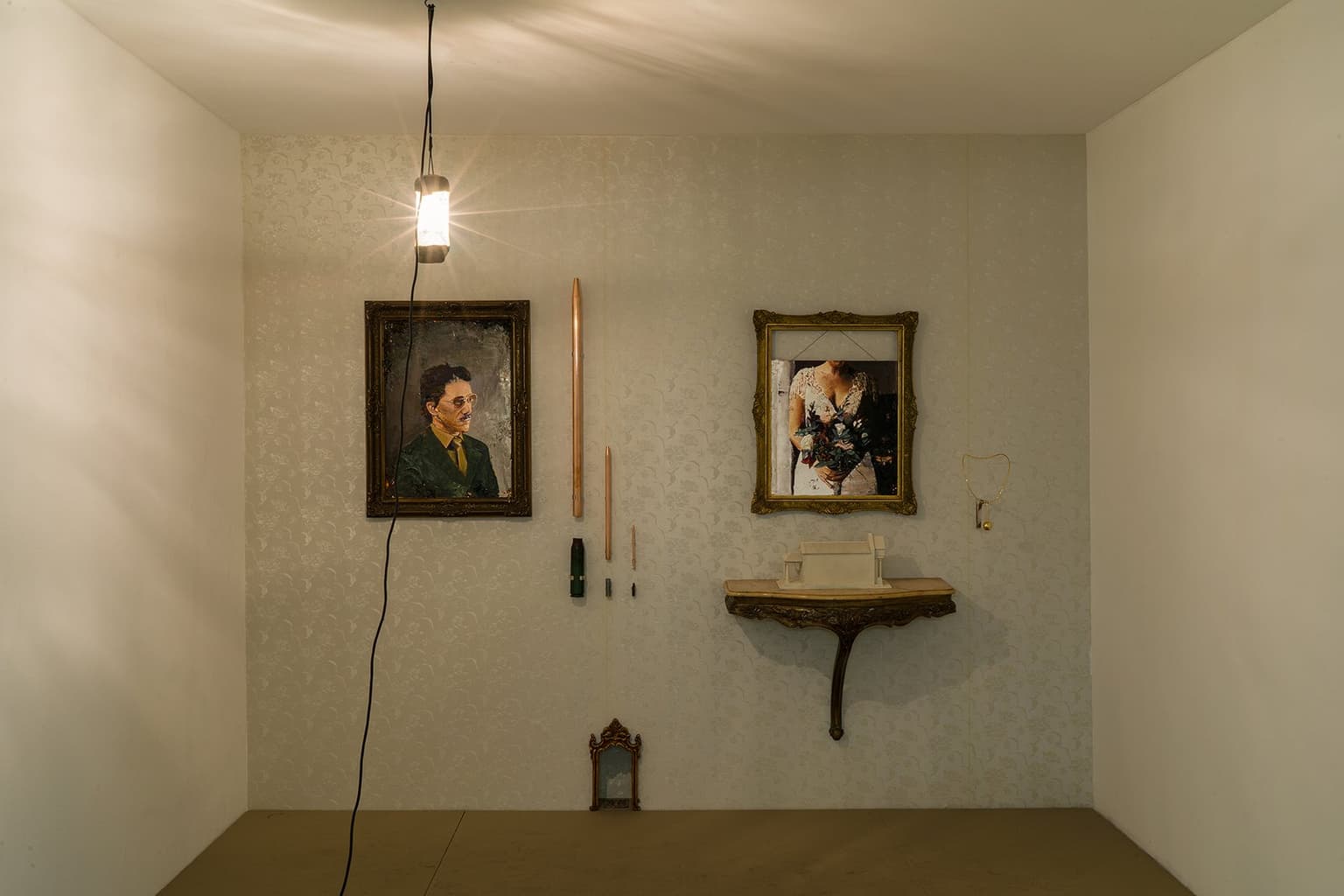
There is a fable that touches very close to the core of life—the fable of the monk who, while walking through a forest, heard a bird break into song, enjoying it for one or two trills, and, upon returning, found himself a stranger at the monastery gates; for he had been absent for fifty years, and of all his comrades, only one had survived to recognize him. […] but of the sound of that time-devouring nightingale’s notes, we have heard no news.
Robert L. Stevenson, The Lantern-Bearers, 1887
On the cutting edge of the bird’s song that fills the installation The Materialization of the Poor-Me-One’s Call (2022), echoes of the tribulations of Latin American dictatorships present themselves in a narrative that is both personal and shared. The trail of low light that cuts through the installation precariously reveals the material composition: separated by three calibers of used bullets and their respective trajectories, rendered in solid copper, are two medium-format portraits. The first, on the left, represents a military officer in an austere pose; formed by a mass of paint that cannot withstand the baroque frame and drips down the edges, dissolving. The second, on the right, shows the half-body of a bride, dressed in a lace gown, holding a floral bouquet at the center of her womb. Her face is cut off by the top of the frame, allowing only her chin to be seen. The canvas fits with notable difficulty into a frame larger than its size, and its mass converges, following gravity, towards a miniature of a church, somewhat modest, placed just below on a wall console. A white church, like the attire of the woman portrayed. Further to the right on the wall, a golden necklace with a round pendant at its center. Below, a small oratory reveals a manhole from which, caged at its bottom, the song of a potoo echoes.
I like to think of Griffo’s painting as masses of paint imbued with baroque, Christian, and, consequently, a unique iconophilia. This materiality thickens the pictorial body with impastos that make the image’s result unstable, almost ready to collapse under its own weight. It is even more curious to note divergent points of color that swarm from the thick blocks of color: here and there, oranges and magentas suggest the beginning of a fire, ready to consume the images. We can also take greater leaps in this relationship between instability and figurativism in the way certain shifting figures repeat in different works; for instance, the fusion of the oratory and the drain, a materialization of a figure that will later appear in the painting The Seller of Miniature Characters (2020); or, taking a big leap, in the installation’s title, similar to the canvas The Giotto exhibition/Continuous dripping/The vocalization of Mother-of-the-Moon (2014). Griffo’s referential system seems to function like an unconscious, oscillating between the great structures of Western art history and the foundations of the figurative ecosystem particular to his practice. In these movements, the artist makes incursions into a time that mixes real tales and fictional elements.
I wish, however, to broaden the focus on the mãe-da-lua bird, also called the Potoo, whose presence in this installation transports the understanding of this narrative to more-than-human meanings. Common in the Amazon Region, the Mother-of-the-moon and its melancholic song are commonly associated with bad omens by rural people. Its lament, with a shrill tone and decreasing cadence, is taken by certain cultures as a presage of death or a warning of imminent danger. In its natural habitat, it is known for camouflaging itself on tree trunks and spending the entire day absolutely inert in an attempt to escape its predators. Although the omen establishes an evident relationship between the sacred and dictatorial power in Latin American history, I do not wish to dwell on this topic to avoid falling into a simplistic reading. However, I must point out the way the sonic element imposes a temporal suspension that puts the visitor on high alert. Hidden in its ability to conceal itself on the horizon, the bird is a witness to historical violence, not only warning but surviving as a narrator.
In consonance with the installation, the painting The End Befitting the Beginning 1 (2019) lies in wait, intensifying the relationships between the divine and the human mediated by Christian material culture. In it, a group of men (divided between those “freed” from the thread leading to the celestial body and those whose line makes them resemble puppets) pays reverence to an imposing oratory. The piece of furniture, which carries a baroque representation of the heavens populated by angels within and still-life scenes on its doors, is placed in a narrow corridor of stone and brick. Illuminated by a channel of cold LED light, the opacity of the walls contrasts with the oratory’s window, which points to the eternal beyond. It thus profanes the religious sphere of rooms extremely loaded with images and decorative elements upon which Christianity founded its bases. The astonishing gesture of temporal displacements proposed by Griffo in his canvases recalls the bird evoked by the British poet Robert Louis Stevenson in The Lantern-Bearers (1887), a time-devouring nightingale that, in his tale, transports a poor monk 50 years into the future to the rhythm of its song. And here we are again, dealing with birds.